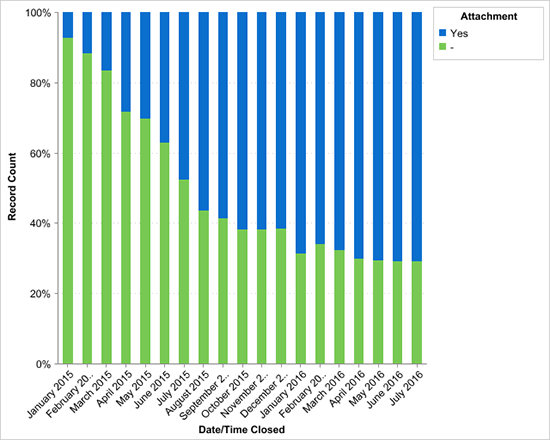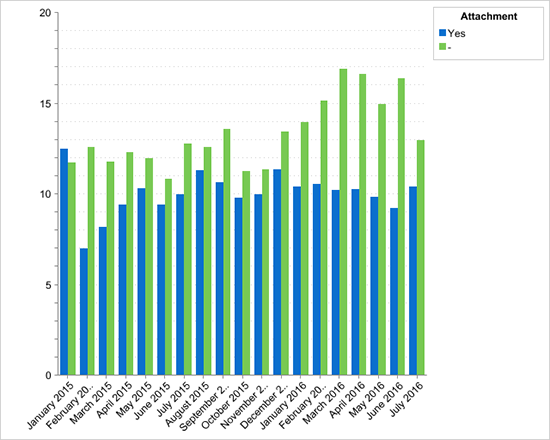Eggs. Sugar. Vanilla. Flour. Chocolate Chips. Salt. Butter. Baking Soda. Brown Sugar.
All of those are essential ingredients to make a pretty awesome chocolate chip cookie. But do I need all of them? Why is every ingredient important? Why do I need salt? Why do I need brown sugar? Do I really need liquid chicken in my cookies?
Well, the answer is simple: Yes. If you want the recipe to look and taste right, each ingredient is important. Even those eggs that you called ”liquid chickens” are important.
This is basically how I started my conversation about Knowledge-Centered Service (KCS) with management at Aspect.
Aspect had tried KCS before. So, they were reluctant to try it again because, according to those involved at the time, KCS failed. Since we didn’t really have anyone active with KCS in the company anymore, they allowed me to go to a KCS Principles course to find out more about it. There still appeared to be a glimmer of hope! Maybe we could make it work if we tried again!
When I came back from the course armed with the knowledge I gained, I knew why KCS failed the first time. It was because we left out some of the ingredients. KCS is a methodology that incorporates knowledge as a key component for service delivery and includes specific elements to follow for success. We didn’t really have key components of KCS such as an active coaching program to maintain quality, report on progress of the individual agents, or groom coaches to be the change agents that we needed. We also didn’t have a KCS Council to help us continuously evolve the KCS program over time.
I knew why KCS failed the first time.

Heck, we even did some of the things that KCS specifically says you should avoid doing, such as requiring people to write a particular number of articles a month. We had also required article attachment before you could close a case. It didn’t matter if the article applied or was helpful or not. The system would not allow for case closure if you didn’t have an article attached. Believe it or not, we actually had articles titled “Use this article to close your case.” We had articles titled “How to get to my desk.”
Our implementation drove the wrong behavior. As time went on and more and more people were creating articles just to meet an arbitrary goal and attaching just to close the case, the knowledge base (KB) became more and more useless. No one trusted the KB because it wasn’t searchable or usable anymore. When you take searchable and usable from a knowledge base, you just have garbage.
In short, we didn’t follow the recipe. We called it KCS, but it wasn’t really. Nothing that was established resembled the KCS I learned.
When I started putting the problem in terms that everyone could understand, management and our other staff that were skeptical started to understand where we had failed. They understood that, in order to have something that was useful, we had to follow the recipe. I mean, sure, you can modify the recipe if you like. But you still need the basic elements of the recipe to make it successful.
If KCS were a cookie recipe, we could replace the chocolate chips with butterscotch chips or white chocolate. We could add walnuts or pecans. However, we needed the basic building blocks of the recipe before we could go about changing it. This understanding was the first step to changing minds.
When we received approval to move forward with adopting KCS across the support organization again, we had an uphill battle in front of us. The easiest part of KCS was actually deciding on the business processes, implementing Salesforce Knowledge, and creating the documentation. But KCS had a bad reputation with many people in the company over the years due to the incorrect application of it. We now had to get people to trust the KB again. They needed to start using it as a resource. We had to get people to believe that we weren’t trying to get their knowledge just so we could fire them.
When we launched the Knowledge application, adoption was light for the first six months. Management kept asking me, “Why?”
The problem was multi-pronged. We had people with very long tenure which is both good and bad. Many of my coworkers had been on the help desk for more than five years, some more than 10, 15, even 20 years! They had seen it all. They felt this initiative was another flash-in-the-pan, something that, if they ignored it, would just go away. Others had already adapted to not having a reliable KB by hoarding knowledge on their computers either in Outlook or in Word documents. Trying to get people to change was not easy.
But the biggest reason adoption was light was because we hadn’t put all the ingredients in the bowl yet. We didn’t have the KCS Coaches program going yet, and we didn’t have a KCS Council. We were leaving out some very important ingredients. I still didn’t have approval to get more than 30 agents off the phone to train them on KCS and how to become effective KCS Coaches. This would require an investment of not only time but money as well, and we just hadn’t received approval to do that yet.
Finally, after months of explaining that we hadn’t seen much success yet because we hadn’t followed the recipe, we got approval to move forward with the plan to start selecting agents, getting them KCS Foundations Certified, and developing our own KCS Coaches training workshop.
I envisioned our KCS Coaches as our change agents. They were the people who were going to put this KCS program on the right track. Try as I might, it was impossible for me to do what was needed for a help desk of more than 400 people. We needed to evaluate what the agents had already written. We had to give them feedback. We had to meet with them regularly. We had to keep on top of their progress. That was way too much for one person and almost too much for the 32 people we brought on board.
When selecting the agents, we asked the team managers to select people on their teams who were trusted change agents and role models and had strong communication skills and influence. From that list we started to put together a workshop and started scheduling time, buying plane tickets and hotel rooms, so we could deliver this workshop in our offices around the world.
Our workshop covered a variety of topics. We initially started off talking about why we were doing this and talked about the ”golden circle,” a concept from writer/speaker Simon Sinek. He talks about how many businesses focus on the what and how but never the why of a project. So, we started with the why to try to get people to understand why we were doing what we were doing and then moved on to the what and how through the following days. Our agenda after discussing the why focused on what we were trying to achieve and what the role of a coach is in our organization. We talked about the steps we felt we needed to take to achieve success. We then went into the BEST communication styles evaluation so others could understand how they communicate and what to be mindful of when talking with the people they coach. Finally, we ended with how we envisioned our KCS program and how to actually score articles and hold meetings with the agents they were going to coach.
Once we had our workshop hammered out, my co-worker and I delivered our workshop in Nashville, Atlanta, San Francisco, London, and Bangalore. We were both nervous about how it would be received as neither one of us had done this before. We had put all of our trust into KCS and the program, hoping it would deliver on what was promised. After all, if this didn’t work after all the time and money invested, we would have liquid chicken on our faces!
After our first KCS Coaches training session in Brentwood, we noticed an immediate uptick in people attaching knowledge against their cases—Use It in Use It, Flag It, Fix It, Add It (UFFA) terms. In practical terms, it wasn’t much. But we went from 1 percent of our cases having knowledge attached to 5 percent in the matter of a week, a 400 percent increase. So, to us, we had something to celebrate.
Within a month or so, we had gone all around the US and halfway around the world and were back in the US, basking the glow of a job well done. The numbers started climbing week after week, month after month. Finally, by the end of the year, we had grown from 1 percent of our cases closed with a knowledge article to 66 percent of them being closed with a knowledge article—a 6500 percent increase! Everyone who was paying attention was floored by the success of the KCS program in such a short amount of time. The chart below shows the growth in number of knowledge articles used.

Once we started seeing our Use It numbers grow, we started checking our other statistics. Articles making it to customers and partners started to grow, too. We would only publish articles to those channels once an article had been used three times or more (and was appropriate/safe to do so). The chart below shows our growth in publishing to customers and partners from the start of 2015 through to our most recent, complete month.

Once the KCS Coaches really started to focus on getting people to do the right thing and share their knowledge if they found out about an undocumented issue, our Add It numbers really took off as well. You can see in the chart below where we started in June 2014 with the new KB. It wasn’t until January of 2015, when we started the KCS Coaching program, that those numbers started to really take off.

We also started to notice that our Average Days to Close (below) started to improve as well. The days to close with an article versus without was always much shorter. In all, we couldn’t have asked for a better response. And we felt it was due to finally following the recipe.

In all, our implementation of KCS had lots of challenges along the way. We had to change minds, attitudes, and the way people work. We had to get buy in using a term—KCS—that had a negative connotation due to people not applying KCS in the correct way in the past.
If I can give one piece of advice to those reading this today, it would be about communication. Communicate with directors. Communicate with managers. Communicate with support agents. The easy part for us was writing the articles. The hard part was changing minds and attitudes. It took time and lots of effort and lots of repeating myself before it took hold. It wasn’t done in six weeks or even six months. But it was worth it; trust me.
It wasn’t as easy as making chocolate chip cookies. But, then again, nothing worth doing has ever been easy. You can start by following the recipe.
Joshua Barker is senior business analyst in the global operations department at Aspect Software. He has been with Aspect for more than seven years and the head of the Knowledge Program for nearly three years. He started pursuing ways to make knowledge better for Aspect shortly after starting with the company. He noticed that the Knowledge Center was not as good as it could be and started working with others to improve it. Finally, after four years of work, he was asked to lead the new knowledge initiative. Josh has been in the IT industry since 2002, occupying various roles in sales, support, and operations. His background in radio, television, public speaking, and debate have proven helpful as he made his transition into his latest role as the knowledge manager for Aspect Software. Connect with Josh on LinkedIn.